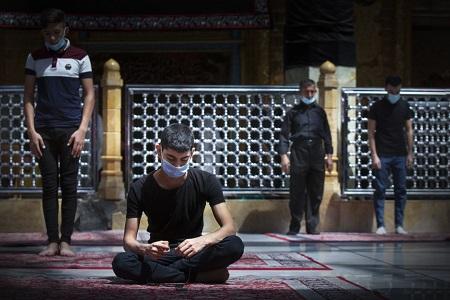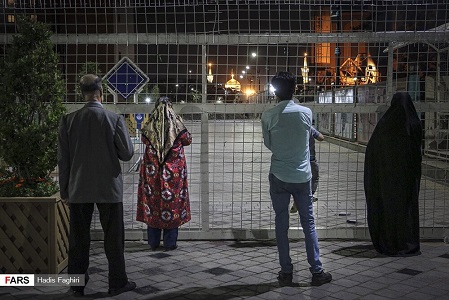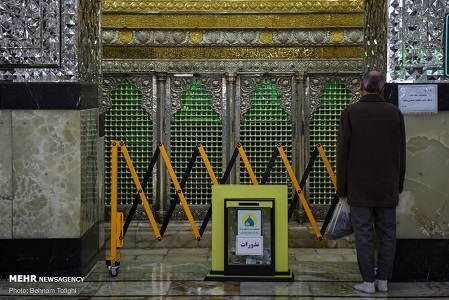You are here
- Home
- “Social Distance” against “Closeness” Reconsidering the issue of closeness in the shiite Islam festivals under the covid-19 pandemic
“Social Distance” against “Closeness” Reconsidering the issue of closeness in the shiite Islam festivals under the covid-19 pandemic

Youth praying inside the shrine of Al-Abbas. Photograph by
Hussein al-Qar'awi / Alkafeel Global Network
Since its origin in the 7th century, as an early schism in Islam’s history, Shiite Islam has developed numerous and specific religious festivals. These festivals are held in various Shiite-populated lands, from the Middle East to South Asia, East Africa, and Southeast Asia, and in recent years around the world, by the Shiite diaspora. The pilgrimage to the graves of the saints, mostly Shiite Imams, alongside the journey to Mecca to perform the Hajj rituals, is an essential element of Shiite culture. In addition to these pilgrimages, the annual mourning ceremony of Ashura in the memory of the martyrdom of Hussein bin Ali, the grandson of Prophet Muhammad and the third Shiite Imam, is considered another seminal Shiite festival. Shiites have long practiced the rituals of pilgrimage and mourning, going back to the constitutive years of Shiism until now.
In terms of the space to hold festivals, no particular place is required to perform the mourning rituals of Ashura. In the days leading up to Ashura, Shiites gather in pre-planned locations or temporarily places, and engage in mourning ceremonies, which usually include speeches and mourning ceremonies. Contrary to the spaces used for the Ashura ceremonies, Shiite shrines are now scattered throughout much of the Middle East and South Asia, and millions of Shiites take part in various pilgrimage rites each year, some of these involving cross-border journeys.

Iran - the city of Mashhad, 2020 - The shrine is closed and pilgrims pray at the gates
Photograph by Hadis Faghiri / Khabar Online
In both pilgrimage and mourning festivals, the gathering of believers is a fundamental principle. Mourning festivals occur by the gathering of several people. In the case of pilgrimages, although these can be undertaken individually, for various reasons, the practice often involves gathering of people. Many believers attend the shrine at the same time, with crowds growing during some days of the religious calendar. New intellectual changes, religious revival, and technologies, especially transportation logistics, which have made significant progress in recent decades in the Middle East and South Asia, have increased the number of pilgrims gathered in the Shiite shrines.
The concept of Islamic pilgrimage, including Hajj, presupposes some commandments or recommendations that make the believers’ bodies closer to each other. A number of these instructions refer to specific activities that believers must perform during these rituals. In Hajj, circling the Kaaba seven times counter clockwise and performing symbolic stoning of the devil by throwing stones at three pillars, at a specific time, cause large crowds to gather in close proximity of each other.
On the other hand, religious commands during the pilgrimage also lead to gatherings in specific parts of the shrines. According to these instructions, whilst attending the shrine, the Shiites recite phrases that indicate their confession of the oneness of God and the greatness of the saint, whilst trying to get as close as possible to the grave of the saint. Shiites generally try to touch and bless the holy tombstone. The effort to get closer to the saint makes the pilgrims inevitably get closer to each other. It is this mass attempt to get closer to the saint, and the subsequent crowded space that is created, that defines the very passion of visiting a Shiite shrine. It is during this time that the pilgrims repeat their prayers aloud, whilst the shrine officiants release unique scents in the shrine. This proximity and crowdedness constitute the unique olfactory environment and soundscape inside the Shiite shrines. It is these material elements, formed within an architectural space created with much artistry, along with the immaterial elements of religious and theological beliefs, that form the rich experience of the pilgrimage, that encapsulates Shiite festivals.

Iran - the city of Tehran, 2020 - Iranian pilgrims not able to approach the grave due to the barrier. Photograph by Behnam Tofighi / Mehr News
With the advent of COVID-19 around the world, areas with significant Shiite populations soon became involved in debating how festivals could be held. Shiite scholars generally refused to hold Ashura festivals in 2020 as these happened in previous years, whilst curtailing visits to shrines. On the other hand, Shiite theological arguments made it possible for some Shiites to perform pilgrimage remotely, by using modern technologies. However, these changes strongly challenged the issue of closeness in Shiite festivals. It would be simply impossible to hold these festivals as they were celebrated in the past. Thus in 2020, although Shiites held most of their festivals, they all lacked their characteristic crowdedness and, therefore, closeness: shrines were closed, and Ashura ceremonies were held symbolically by joining a small number of people, as allowed by their respective state legislation. Some Shiites gathered around the closed shrines and could no longer approach the graves of saints and perform their blessing rites.
The practice of “social distance”, together with quarantine and isolation, had a fundamental impact on Shiite festivals in 2020. It is true that the pandemic did not make festivals disappear and even contributed to new techniques and strategies to make the pilgrimage and hold mourning sessions, via digital technologies. Yet by affecting the defining closeness that represents the materiality of Shiite festivals, the Covid-19 pandemic limited some of the most crucial religious experiences – in an unprecedented fashion.
.jpg)
Peyman Eshaghi is PhD. Candidate at the Berlin Graduate School Muslim Cultures and Societies, Free University of Berlin, Germany.
He has previously studied at the University of Chicago, University of Ankara, and the University of Tehran in the fields of anthropology and sociology of religion. His main areas of research are the Hajj and pilgrimage in Islam and Iran-Ottoman relationship. Among his publications are: Muslim Pilgrimage in the Modern World (co-edited with Babak Rahimi, Chapel Hill: University of North Carolina Press, 2019), “To Capture a Cherished Past: Pilgrimage Photography at Imam Riza’s Shrine, Iran”, Middle East Journal of Culture and Communication, 8 (2-3): 2015, 282–306 p. and “Quietness beyond Political Power: Politics of Taking Sanctuary (Bast Neshini) in the Shi’ite Shrines of Iran”, Iranian Studies, 49(3): 2016 (439-512).
Request your prospectus
![]()
Explore our qualifications and courses by requesting one of our prospectuses today.
